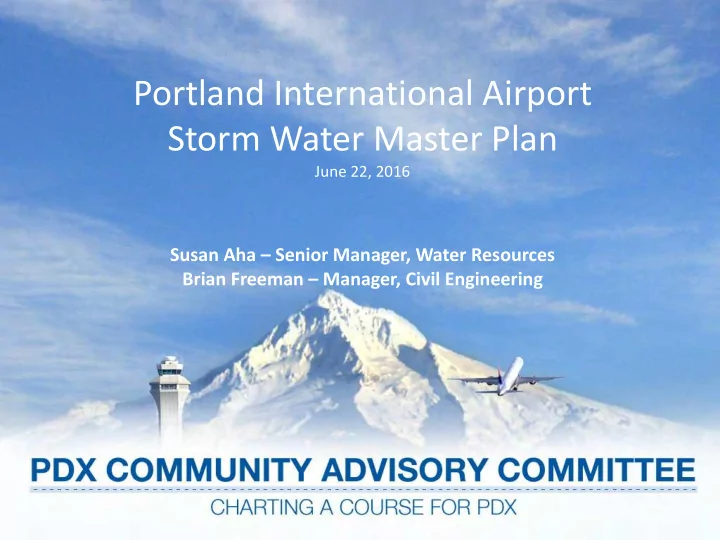

Portland International Airport Storm Water Master Plan June 22, 2016 Susan Aha – Senior Manager, Water Resources Brian Freeman – Manager, Civil Engineering 1
Presentation Overview • Why is storm water important to manage? • PDX storm water drainage basins • Storm Water Master Plan consultant team and goals • Connection to PDX Master Plan (Airport Futures) • Storm Water Master Plan outcomes • Storm water treatment structures • Key drainage basins with issues (1, 2, 7, 8, and 9) 2
GUIDING PRINCIPLES Why is Storm Water Important to Manage? • Rainfall generates storm water runoff • At PDX storm water flows south to the Columbia Slough which is managed for flood control by the Multnomah County Drainage District (MCDD) • Storm water quality and quantity at PDX is primarily regulated by Oregon Department of Environmental Quality National Pollutant Discharge Elimination System (NPDES) permits (delegated by EPA): – 1200-COLS – Municipal Separate Storm Sewer System (City & Port are co-permittees) – Deicing 3
Flooded Building at PDX 4
Flooded Roadway at PDX 5
PDX Drainage Basins 6
PDX Drainage Basins 7
Storm Water Master Plan Consulting Team • Lead: Gresham, Smith and Partners (GSP) – PDX Hydraulic analyses (PDX) • Sub-consultants: – Geosyntec Consultants: Pollutant analyses – HDR Engineering: Marine hydraulic analyses – Good Company (ESB): Sustainability and best management practices – Zenn Associates (ESB): Outreach • Timeline: – Contract awarded January 2013 – Work completed June 2015 8
Storm Water Master Plan Goals • Comply with MS4 and 1200-COLS permit requirements for water quality and quantity • Address surface flooding and wildlife attractants • Plan for future development and redevelopment • Identify aging infrastructure and develop database to support development of an asset management program • Develop recommended list of projects for storm system modifications 9
Interrelationships 1. Evaluate existing and future conditions based on: • PDX Master Plan • Port strategic goals and policies • Regulatory requirements • Safety • Sustainability • Natural resources 2. Integrate solutions into short-term and long-term planning and facility management: • Capital projects • Operations and Maintenance (O&M) projects and activities 10
PDX Drainage Basins and Storm Water Master Plan Outcomes • Functioning Well: Basins 3, 4, 5, and 6 • Undersized and aging infrastructure: Basin 1, 2 and 7 • Wildlife attractant issues: Basins 1, 2, and 8 • Complex ownership: Basins 1, 8, and 9 • Relatively new undersized infrastructure: Basin 8 • Storm water treatment needed: All basins 11
Example of Failing Pipe 12
PDX Storm Water Master Plan Document Storm Water • Program Structure Program • Program Tools Management • Program Resources • Issues and Drivers Storm Water • Operation and Safety Risks from Ponding Planning • Compromised and Aging Storm Water Assets Objectives • Regulatory Requirements Triggered by Development & Redevelopment Storm Water • Existing Drainage System Overview System • Existing Water Quality Controls Description • Drainage Basin Descriptions Implementing • Location-Specific Needs Storm Water • Location-Specific Solutions Improvements • Storm Water Management Fact Sheets 13
Airport-Wide Recommended Regional Storm Water Treatment Structures 14
Basins 1&2: Wildlife Attractants, Complex Ownership, Undersized and Failing Infrastructure Outfalls 1C Outfall 1N and 1S 15 Broadmoor PS PS#2
Basin 8: Wildlife Attractants, Undersized Infrastructure, Complex Ownership 16 Outfall 8
Basin 9: Complex Ownership I-205 Mays Lake MAX Pipe Ownership Key City ODOT Outfall MCDD 17 Outfall 9 ODOT Unknown
Basin 7: Undersized and Ageing Infrastructure Outfall 7 18
New Basin 7 Pipe (“Colwood Pipe”) 19
Basin 7 Straw Pipe 20
Basin 7 Straw Pipe – 5 Year Storm Event and 100% Collapse 21
Hand Excavation for Diversion Culvert 22
60 Inch Corrugated Metal Pipe 23
Pouring Concrete for the Headwalls 24
Functioning Pipe – Work Completed July 1936 25
Conclusion 26
Recommend
More recommend